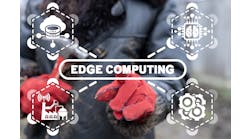By Vamsi Sistla, Bsquare senior director of product innovation, machine learning, IoT & architecture
In today’s manufacturing environment, with sensor-connected machines generating terabytes of data per day, many plant managers are grappling with the same data-storage and processing decision—take the cloud approach or keep it on the edge?
For every cloud benefit, there’s an equally tempting advantage to processing data at the edge, so how can they decide which option is best? Lucky for them, they don’t have to choose; there are great advantages to leveraging both, depending on business priorities.
In traditional IoT architectures, collected data is transported, combined and processed in a data repository, which works well in instances where businesses need to analyze their data collectively. But with businesses looking for a more granular view of their operation, each piece of equipment must quickly analyze data at the point of generation. Gartner lists the increasing need for edge processing as one of the top strategic technology trends of 2019.
With sensors on the edge producing data at an exponential rate, many businesses have already begun integrating edge computing into their IoT deployments. Perhaps you are one of them. Business Insider Intelligence predicts that trend will accelerate—with a total of 5.6 billion enterprise- and government-owned IoT devices utilizing edge computing for data collection and processing in 2020.
Businesses are looking for ways to layer edge processing into cloud workflows for the greatest benefit. Through both computing methods, businesses can analyze data at each generation point and use collected data for a holistic view of how these pieces relate to each other.
Cloud and edge computing at work in a factory
Business Insider Intelligence also expects that the manufacturing, utilities, energy and transportation industries will be the fastest to adopt edge computing. How might a factory combine cloud and edge computing for IoT success?
According to Gartner, edge computing in an IoT deployment usually occurs on assets with sensors or embedded devices. In the factory example, an edge could refer to two different places: (1) each piece of equipment in the facility or (2) the factory itself as an edge-aggregation point, as it consolidates data from all enclosed equipment. The factory would also have data synching and processing ability in the cloud—an important piece when the business has something specific to report or is collecting data across multiple factory sites—making this a hybrid approach for data processing.
This combined cloud/edge infrastructure enables manufacturers to process and manage data wherever it makes the most sense for their operation and objectives, whether that’s in the cloud or at one of the edges. Instead of sending data about anomalies in the production line straight to the cloud, a plant manager may compile that data on the factory floor for quicker analysis, which prompts higher production quality and streamlines overall data management.
Cloud and edge are never mutually exclusive
Leveraging both cloud and edge computing in IoT deployments enables businesses to fuse the strengths of both types of computing, instead of picking one over the other. It’s well documented that the cloud’s larger computation capacity comes with greater transmission latency, impacting response times and bandwidth usage. By striking a balance between edge and cloud computing, manufacturers can enjoy the edge benefits of low latency and device responsiveness, as well as the cloud benefits of scalability, cost-effectiveness and low maintenance. In addition, utilizing edge computing to handle certain types of sensitive data can help mitigate privacy and security risks.
No matter where an organization falls on the edge-to-cloud scale, it’s important that they choose a computing approach that best fits their business needs. Manufacturers that perform analytics at the edge and in the cloud can use real-time data to make faster, more accurate decisions that create real operational value.


